Unit - 1
Basic Electronic Components
Q1) For a series RLC circuit having R=10ohms, L= 0.15H, C=100 F. They are connected across 100v 50Hz supply. Calculate total impedance?
F. They are connected across 100v 50Hz supply. Calculate total impedance?
A1)
Impedance Z= 
Z=  = 18.27ohm
= 18.27ohm
Q2) For a series RLC circuit having R=12ohms, L= 0.2H, C=60 F. They are connected across 100v 50Hz supply. Calculate circuit current?
F. They are connected across 100v 50Hz supply. Calculate circuit current?
A2)
I= 
Z= 
Z=  = 13.89ohm
= 13.89ohm
I = 100/13.89 =7.2A
Q3) For a series RLC circuit having R=10ohms, L= 0.15H, C=100 F. They are connected across 100v 50Hz supply. Calculate power factor?
F. They are connected across 100v 50Hz supply. Calculate power factor?
A3)
Cosφ = 
Impedance Z= 
Z=  = 18.27ohm
= 18.27ohm
Cosφ =  =
= 
φ = 56.81o lagging
Q4) A coil takes a current of 6A when connected to 24V dc supply. To obtain the same current with 50HZ ac, the voltage required was 30V. Calculate inductance and p.f of coil?
A4)
The coil will offer only resistance to dc voltage and impedance to ac voltage
R =24/6 = 4ohm
Z= 30/6 = 5ohm
XL = 
= 3ohm
Cosφ =  = 4/5 = 0.8 lagging
= 4/5 = 0.8 lagging
Q5) The potential difference measured across a coil is 4.5V,when it carries a dc current of 8A. The same coil when carries ac current of 8A at 25Hz,the potential difference is 24V. Find current and power when supplied by 50V,50Hz supply?
A5)
R=V/I= 4.5/8 = 0.56ohm
At 25Hz Z= V/I=24/8 =3ohm
XL = 
= 2.93ohm
XL = 2 fL = 2
fL = 2 x 25x L = 2.93
x 25x L = 2.93
L=0.0187ohm
At 50Hz
XL = 2x3 =6ohm
Z =  = 5.97ohm
= 5.97ohm
I= 50/5.97 = 8.37A
Power = I2R = 39.28W
Q6) A coil having inductance of 50mH an resistance 10ohmis connected in series with a 25 F capacitor across a 200V ac supply. Calculate resonant frequency and current flowing at resonance?
F capacitor across a 200V ac supply. Calculate resonant frequency and current flowing at resonance?
A6) The equation for resonant frequency is
f0= = 142.3Hz
= 142.3Hz
I0 = V/R = 200/10 = 20A
Q7) A 15mH inductor is in series with a parallel combination of 80ohm resistor and 20 F capacitor. If the angular freQncy of the applied voltage is 1000rad/s find admittance?
F capacitor. If the angular freQncy of the applied voltage is 1000rad/s find admittance?
A7)
XL = 2 fL = 1000x15x10-3 = 15ohm
fL = 1000x15x10-3 = 15ohm
XL = 1/ C = 50ohm
C = 50ohm
Impedance of parallel combination Z = 80||-j50 = 22.5-j36
Total impedance = j15+22.5-j36 = 22.5-j21
Admittance Y= 1/Z = 0.023-j0.022 siemens
Q8) A circuit connected to a 100V, 50 Hz supply takes 0.8A at a p.f of 0.3 lagging. Calculate the resistance and inductance of the circuit when connected in series and parallel?
A8)
For series Z =100/0.8 = 125ohm
Cosφ = 
R = 0.3 x 125 = 37.5ohm
XL =  = 119.2ohm
= 119.2ohm
XL = 2 fL = 2
fL = 2 x 50x L
x 50x L
119.2 = 2 x 50x L
x 50x L
L= 0.38H
For parallel:
Active component of current = 0.8cosφ = 0.3x0.3 = 0.24A
R = 100/0.24 =416.7ohm
Quadrature component of current = 0.8 sinφ = 0.763
XL= 100/0.763 = 131.06ohm
L= 100/0.763x2 x50 = 0.417H
x50 = 0.417H
Q9) Calculate impedance of a parallel tuned RC circuit at a frequency of 400kHz and for a BW of operation equal to 20kHz. Given R=5ohm?
A9)
BW =R/2 L
L
L= 39 H
H
f0 = 
C = 2.6x10-9F
Z= L/RC = 3kohm
Q10) List the difference between Inductor and Capacitor?
A10)
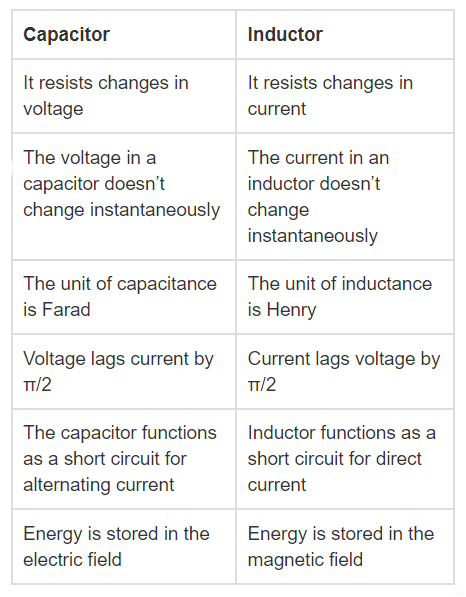
Q11) Compare active and passive elements?
A11)
S.No. | Active Element | Passive Element |
1 | They require external power supply to operate | They do not require external power supply to operate |
2 | They have a function of gain | They do not have a function of gain |
3 | They produce energy in the form of voltage or current | They store energy in the form of voltage or current |
4 | Examples: Semiconductors, diodes and transistors | Examples: Resistor, capacitor and inductors |
Q12) Describe various types of fixed value resistors in detail?
A12) There are many thousands of different Types of Resistors and are produced in a variety of forms because their particular characteristics and accuracy suit certain areas of application, such as High Stability, High Voltage, High Current etc, or are used as general-purpose resistors where their characteristics are less of a problem.
Some of the common characteristics associated with the resistor are; Temperature Coefficient, Voltage Coefficient, Noise, Frequency Response, Power as well as a resistors Temperature Rating, Physical Size and Reliability.
All modern fixed value resistors can be classified into four broad groups:
- Carbon Composition Resistor – Made of carbon dust or graphite paste, low wattage values.
- Film or Cermet Resistor – Made from conductive metal oxide paste, very low wattage values
- Wire-wound Resistor – Metallic bodies for heatsink mounting, very high wattage ratings
- Semiconductor Resistor – High frequency/precision surface mount thin film technology
Carbon Resistors are the most common type of Composition Resistors. Carbon resistors are a cheap general purpose resistor used in electrical and electronic circuits. Their resistive element is manufactured from a mixture of finely ground carbon dust or graphite (similar to pencil lead) and a non-conducting ceramic (clay) powder to bind it all together.
The Carbon Composite Resistor is a low to medium type power resistor which has a low inductance making them ideal for high frequency applications but they can also suffer from noise and stability when hot. Carbon composite resistors are generally prefixed with a “CR” notation (eg, CR10kΩ ) and are available in E6 ( ± 20% tolerance (accuracy) ), E12 ( ± 10% tolerance) and E24 ( ± 5% tolerance) packages with power ratings from 0.250 or 1/4 of a Watt up to 5 Watts.
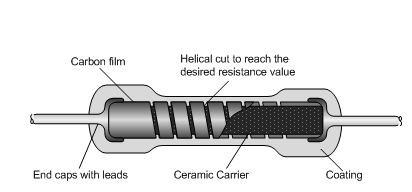
Fig: Carbon composite resistor
Film Type Resistors
This resistor consists of Metal Film, Carbon Film and Metal Oxide Film resistor types, which are generally made by depositing pure metals, such as nickel, or an oxide film, such as tin-oxide, onto an insulating ceramic rod or substrate.

Fig: Film Resistor
The resistive value of the resistor is controlled by increasing the desired thickness of the deposited film giving them the names of either “thick-film resistors” or “thin-film resistors”. Once deposited, a laser is used to cut a high precision spiral helix groove type pattern into this film. The cutting of the film has the effect of increasing the conductive or resistive path, a bit like taking a long length of straight wire and forming it into a coil.
Metal Film Resistors have much better temperature stability than their carbon equivalents, lower noise and are generally better for high frequency or radio frequency applications. Metal Oxide Resistors have better high surge current capability with a much higher temperature rating than the equivalent metal film resistors.
Another type of film resistor commonly known as a Thick Film Resistor is manufactured by depositing a much thicker conductive paste of CERamic and METal, called Cermet, onto an alumina ceramic substrate.
Metal Film Resistors are prefixed with a “MFR” notation (eg, MFR100kΩ) and a CF for Carbon Film types. Metal film resistors are available in E24 (±5% & ±2% tolerances), E96 (±1% tolerance) and E192 (±0.5%, ±0.25% & ±0.1% tolerances) packages with power ratings of 0.05 (1/20th) of a Watt up to 1/2 Watt.
Wire wound Type of Resistor
Another type of resistor, called a Wire wound Resistor, is made by winding a thin metal alloy wire (Nichrome) or similar wire onto an insulating ceramic former in the form of a spiral helix similar to the film resistor above.
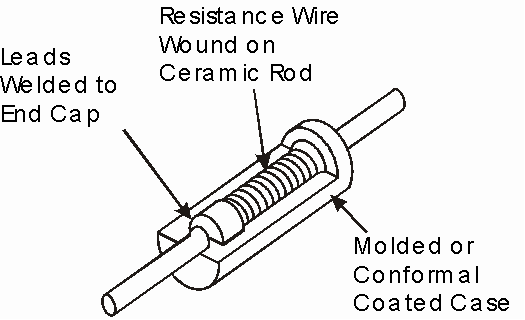
Fig: Wire wound Resistor
These types of resistors are generally only available in very low ohmic high precision values (from 0.01Ω to 100kΩ) due to the gauge of the wire and number of turns possible on the former making them ideal for use in measuring circuits and Wheatstone bridge type applications.
Wire wound resistor types are prefixed with a “WH” or “W” notation (eg WH10Ω) and are available in the WH aluminium clad package (±1%, ±2%, ±5% and ±10% tolerance) or the W vitreous enamelled package (±1%, ±2% and ±5% tolerance) with power ratings from 1W to 300W or more.
Q13) Explain the resistance colour code system in detail?
A13) Calculating Resistor Values by colour Code
The Resistor Colour Code system is all well and good but we need to understand how to apply it in order to get the correct value of the resistor. The “left-hand” or the most significant coloured band is the band which is nearest to a connecting lead with the colour coded bands being read from left-to-right as follows:
Digit, Digit, Multiplier = Colour, Colour x 10 colour in Ohm’s (Ω)
For example, a resistor has the following coloured markings;
Yellow Violet Red = 4 7 2 = 4 7 x 102 = 4700Ω or 4k7 Ohm.
The fourth and fifth bands are used to determine the percentage tolerance of the resistor. Resistor tolerance is a measure of the resistors variation from the specified resistive value and is a consequence of the manufacturing process and is expressed as a percentage of its “nominal” or preferred value.
Typical resistor tolerances for film resistors range from 1% to 10% while carbon resistors have tolerances up to 20%. Resistors with tolerances lower than 2% are called precision resistors with the or lower tolerance resistors being more expensive.
Most five band resistors are precision resistors with tolerances of either 1% or 2% while most of the four band resistors have tolerances of 5%, 10% and 20%. The colour code used to denote the tolerance rating of a resistor is given as:
Brown = 1%, Red = 2%, Gold = 5%, Silver = 10 %
If resistor has no fourth tolerance band then the default tolerance would be at 20%

Resistor Colour Code Table

Q14) Explain the working of IC 555 timer with proper block diagram?
A14)
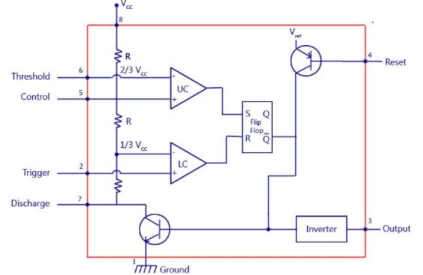
Fig: IC 555 Timer
For IC555 timer working as a flip flop or as a multi-vibrator, it has a particular set of configurations. Some of the major features include:
- It operates from a wide range of power ranging from +5 Volts to +18 Volts supply voltage.
- Sinking or sourcing 200 mA of load current.
- The external components should be selected properly so that the timing intervals can be made into several minutes along with the frequencies exceeding several hundred kilohertz.
- The output of a 555 timer can drive a transistor-transistor logic (TTL) due to its high current output.
- It has a temperature stability of 50 parts per million (ppm) per degree Celsius change in temperature which is equivalent to 0.005 %/ °C.
- The duty cycle of the timer is adjustable.
- Also, the maximum power dissipation per package is 600 mW and its trigger and reset inputs has logic compatibility.
Q15) Explain construction and working of cathode ray oscilloscope?
A15) They are generally used in laboratories. They are used to measure various waveforms. This device is very fast in plotting two dimensional characteristics. In this instrument a beam of electrons strikes a luminous screen and produce luminous spots. These spots move according to the variation of input variable.
Construction of CRO
The CRO consists of
1) Cathode ray tube: It is a vacuum tube which converts electrical signal into the visual signal. It has an electron gun and electrostatic deflection plates. A focused beam of electrons of high frequency is produced by electron gun. The electron beam is moved left to right by horizontal beam and vertical deflection plate moves the beam up and down.
2) Electronic gun assembly: This gun emits electron and form them into beam. It has heater, cathode, a grid, a focusing anode and an accelerating anode. There is a layer of barium and strontium to provide high emission of electrons at moderate temperature. The electron passes to control grid from the cathode grid. The CRO uses an electrostatic focusing tube.
3) Deflecting plate: The electron beam passes through two pair of deflecting plate after leaving the electron gun. The vertical deflecting plate produces vertical deflection and horizontal deflecting plate produces horizontal deflection.
4) Fluorescent Screen for CRT: The front of CRT is called face plate. It formed by shaping molten glass. The inner surface is coated with phosphor crystal which converts electric energy to light energy. When electron beam strikes the surface their energy level is raised and hence light is emitted.
5) Glass Envelop: It is conical shaped structure. There is aquadag coating between screen and inner surface of CRT. This surface is electrically connected to accelerating anode helping the electron beam to focus.
Working
The CRO figure is shown below. The electron is injected through control grid. This control grid has to control the light intensity of electron. The intensity of light depends on the negative potential of control grid. If the negative potential is low bright spot is produced and vice versa.
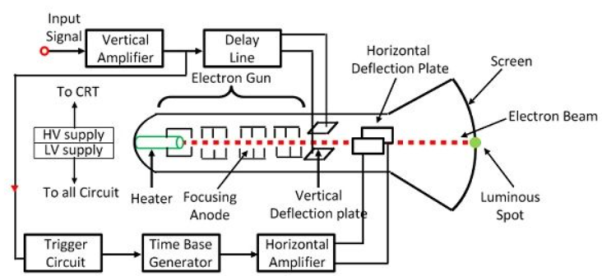
Fig: CRO
The electron beam further passes through focusing and accelerating anodes. These anodes being at high positive potential converge the beam to a point on screen. The beam than comes under the deflecting plates. The beam produces a spot when deflecting plate is at zero potential. The electron beam focuses upward when voltage is applied to vertical plate, and it is deflected horizontally when the voltage is applied to horizontal plate.
Q16) How can we measure voltage, current and frequency using CRO?
A16) Measurements of Voltage and Current
For measuring direct voltage, the spot is focused on the centre without applying any voltage to the deflection plate. The deflection of the spot is noticed on screen after applying direct voltage in between the deflection plates. The direct voltage is equal to the product of magnitude of deflection and the deflection factor. For measuring AC voltage, it is applied between pair of deflection plate and the straight line is measured.
The current to be measured is passed through a known non-inductive resistance and the voltage across it is measured. The current can be determined by dividing the voltage drop by non-inductive resistance.
Measurement of Frequency
The pattern on CRO screen is called as Lissajous pattern. These patterns are stationary on screen. There are two types of Lissajous patterns open pattern with free ends and closed pattern with no free ends.
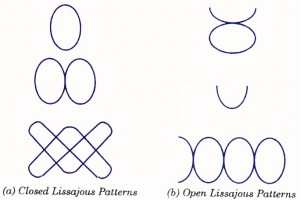
In these patterns the ratio of frequency of vertical signal to frequency of horizontal signal is equal to ratio of y-peaks to X-peaks. Thus, by counting the positive Y-peaks and X-peaks on a Lissajous pattern, ratio of frequencies of two voltage signals can be determined.
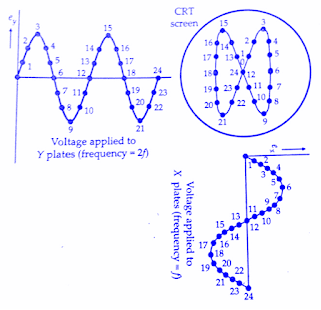
When a sine wave is applied to both plates but the frequency of wave at Y plate is twice to that of the X plate. Then the output will have a pattern of 8 with two loops because both the waves start at same instance. But when same frequency wave does not start at same instance the patterns obtained are below
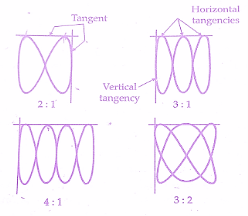
The ratio of frequency will be
 =
= 
The above equation will not hold for Lissajous pattern with free ends. For this case the equation becomes
 =
= 
Q17) Explain with block diagram the working of function generator?
A17) The function generator is an instrument which generates different types of wave form. The most required common wave forms are sine wave, saw tooth wave, triangle wave, square wave and these various outputs of the generator are available simultaneously. The purpose of providing simultaneously waves is fulfilled by the function generator. In function generator the o/p waveform can be generated at a desired freqn in range from few hertz to several kilohertz. In the function generator the freqn is controlled which drives the integrator. The freqn controlled vtg is used to regulate two current source namely upper current source and lower current source. The upper current source supplies constant current to an integrator. The o/p vtg of integrator then increases linearly with time.If the current charging the capacitor increases or decreases the slope of o/p vtg increases or decreases respectively. Hence this controls freqn.
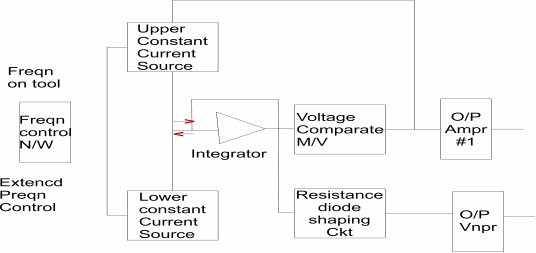
Fig: Block diagram of function generator
- The voltage comparator multi vibrator circuit changes the state of the n/w when the o/p vtg of integrator equals the maximum predetermined upper level.
- Because of this change in state the upper current source is removes and the lower current source is switched on
- This lower current source supplies opposite current to the integrator or ckt. The o/p of integrator decreases linearly with time when this o/p vtg equals maximum predetermine upper level on –ve side the comparator multi vibrator again changes the condition of the n/w by switching off the lower current source and switching on the upper current source
- The o/p vtg of the integrator has triangular wave form
- The freqn of this triangular wave form is determined by the upper current source and lower current source
- To get square wave the o/p of the integrator is passed through comparator.
- The vtg comparator delivers square wave o/p vtg of same freqn as that of i/p triangular wave form
- The sine wave is derived from triangular wave. The triangular wave is synthesised in to sine wave using diode resistance n/w in this shaper ckt , the slope of triangular wave is changed as it amplitude changes. This result in a sine wave with less than 1% distortion
- The two o/p amplifiers provide two simultaneous individually selected o/p of any of the wave form functions.
Application:
- It is used to generate different types of waves form simultaneous such as sine wave, square wave, triangular wave & saw tooth wave at a desired frequency from few hertz to several kilohertz.
- It is used to test bandwidth of audio frequency amplifier using square wave testing method
- It can be used in trouble shooting of various Analog as well as digital instruments.
- It is most extensively used as signal source for radio receiver alignment procedure.
Q18) With the help of block diagram explain the working of digital multi-meter?
A18)
- A Multi meter the most common measuring instrument. The name comes from multiple meters. There are two common types of Multi meter.
- The mult imeter (DMMs) are the most common Measurement readings are displayed as numerical values on the LCD display. The display also alerts you to any pertinent symbols and warning.
- Digital meters on the other hand offer high accuracy have a high i/p impedance and are smaller in site.
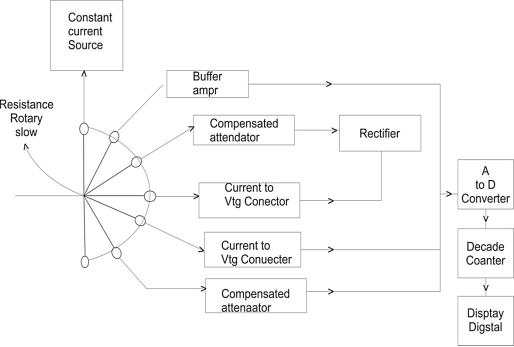
Fig: Block Diagram of Multimeter
An instrument which is capable of measuring a.c. And d.c voltages a.c and d.c. Current and resistances over several range is called digital multimeter. The various measurement possible by DMM are resistance a.c voltage and current d.c voltage and current.The selection of the parameter is possible with the help of rotary switch connected to i/p probes of DMM.
- Resistance Measurement: The rotary switch is in position 1 and resistance is connected to input probes. The constant current source Drives a current through unknown resistance. This produces Voltage across resistance which is directly proportional to the resistance. It is given to the buffer amplify and then to analog to digital converter. The ADC converts it to equivalent digital signal and it is displayed with the help of digital display a.c voltage measurement : The rotary switch is in position 2 and i/p a.c voltage is applied to probes if it is above the selected range it is attenuated with the help of compensated attenuator It is rectified to produce proportional d.c voltage then it is given to ADC which display it in volts
- A.c current measurement: the rotary switch is in position 3 and unknown current is applied across i/p probes it is converted to proportional voltage using current to voltage convertors
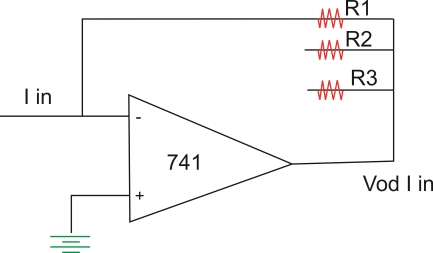
This I V converter is op-amp circuit as shown above. The op-amp/p current is zero hence I in flows through R1 and drop across R1osVo hence vtg o/p  the resistance R1 R2 and R3 are used for the proper range selection. This vtg is rectified and then given to ADC which sisplays the current in amperes.
the resistance R1 R2 and R3 are used for the proper range selection. This vtg is rectified and then given to ADC which sisplays the current in amperes.
3. D.c current measurement : The rotary switch is in position 4 and unknown d.c current is applied across i/p probes this vtg is given to ADC without rectification as this is proportional to d.c current ADC display it in amperes on digital display.
4. D.C voltage measurement : The rotary switch is in position 5 and unknown vtg is applied across i/p probes it is attenuated and directly given to ADC display it in volts.
Q19) List all the specifications of digital multimeter?
A19) Specifications of Digital Multimeter:
- D.C Voltage : this includes various d.c vtg ranges available along with the resolution and accuracy
- A.c Voltage : this includes various a.c vtg ranges available along with the resolution and accuracy.
- A.C current : this includes various a.c current ranges available along with the resolution and accuracy.
- Resistance : this includes the available resistance range typical six range are available from 200Ω to 20 MΩ the accuracy is
 0.1% of reading + two digits + 0.002Ω on the lowest range.
0.1% of reading + two digits + 0.002Ω on the lowest range. - Input Impedance : The i/p Impedance is about 10 MΩ on all the range
- Normal mode noise rejection : this indicates the ability of the meter
It is greater than 60 dB at 50 HZ while the common mode noise rejection is greater than 90 dB at 50 HZ and greater than 120 dB at d.c
7. Overload protection: The overload protection of 1000 V d.c and 75 0ɤ.m.s. a.c is provided.
8. Diode test: The vtg drop across the diode can be measured for which 1 mA + 10% of constant current source is used.
9. Conductance: It can display Conductance in siemens
10. Relative Reference: when RF1 button is pressed the displayed reading is stored as a reference and then subtracted from the subsequent readings to indicate only amount of deviation from the reference.
11. Frequency: The frequency ranges is 200HZ to 200 kHZ auto selection.
Q20) What are relays. Explain static relay in detail?
A20) A relay comprises of an electromagnet and a contact unit. Activating the contact unit using electromagnetic attraction, which is produced when electric current exceeding the specified value flows to the electromagnet; the voltage and current (input signal) applied to the coil opens or shuts the contact. Relays used for
- As interfaces between control circuits and load circuits,
- For signal multiplication,
- For separation of direct current and alternating current circuits
- Linking information.
The working principle of the Solid Static relays is similar to that of the Electromechanical Relay which means the Solid Static relays can perform tasks that the Electromechanical Relay can perform. The Solid Static relays use analogue electronic devices instead of magnetic coils and mechanical components to create the relay characteristics. The measurement is carried out by static circuits consisting of comparators, level detectors, filter etc while in a conventional electro-magnetic relay it is done by comparing operating torque (or force) with restraining torque (or force). The relaying quantity such as voltage/current is rectified and measured. When the quantity under measurement attains certain well-defined value, the output device is triggered and thereby the circuit breaker trip circuit is energized.

Fig: Static Relay
The essential components of static relays are shown in fig. The output of CT and PT are not suitable for static components so they are brought down to suitable level by auxiliary CT and PT. Then auxiliary CT output is given to rectifier. Rectifier rectifies the relaying quantity i.e., the output from a CT or PT or a Transducer.
The rectified output is supplied to a measuring unit comprising of comparators, level detectors, filters, logic circuits. The output is actuated when the dynamic input (i.e., the relaying quantity) attains the threshold value. This output of the measuring unit is amplified by amplifier and fed to the output unit device, which is usually an electro-magnetic one. The output unit energizes the trip coil only when relay operates.
Advantages of Solid-State Relay:
- Static Relay burden is less than Electromagnetic type of relays. Hence error is less.
- Low Weight
- Required Less Space which results in panel space saving.
- Arc less switching
- No acoustical noise.
- Multi-function integration.
- Fast response.
- Long life (High Reliability): more than 109 operations
- High Range of Setting compared to electromechanical Relay
- More Accurate compared to electromechanical Relay
- Low Electromagnetic Interference.
- Less power consumption.
- Shock and vibration resistant